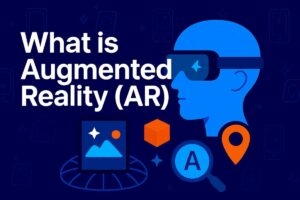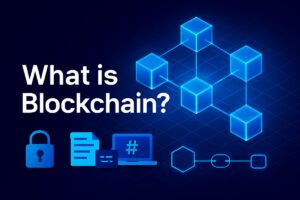A Non-Fungible Token (NFT) is a unique digital asset stored on the blockchain that proves ownership of art, music, collectibles, or real-world items. Unlike cryptocurrencies, NFTs are not interchangeable. This guide explains what NFTs are, how they work, their benefits, risks, and how they’re shaping the future of digital ownership in 2025 and beyond.
In 2021, a digital artwork by Beeple sold for $69 million. But it wasn’t a physical painting—it was an NFT.
Since then, NFTs (Non-Fungible Tokens) have disrupted how we buy, sell, and own digital content. From digital art to music, gaming, real estate, and even identity management—NFTs are redefining ownership in the digital age.
But what exactly are NFTs? How do they work? Why are they valuable? And more importantly, what does the future hold?
In this guide, we’ll break it all down in simple terms for a mixed audience—whether you’re a student, creator, investor, or just curious.
What is a Non-Fungible Token (NFT)?
A Non-Fungible Token (NFT) is a unique cryptographic digital asset that represents ownership of something—often digital—using blockchain technology.
- Non-fungible means it cannot be exchanged for another asset of equal value (unlike Bitcoin or rupees).
- Each NFT has distinct metadata and a unique ID, making it one-of-a-kind.
NFTs are typically built using Ethereum’s ERC-721 or ERC-1155 standards, but other blockchains like Solana, Flow, and Polygon also support them.
Think of an NFT as a digital certificate of authenticity—just like the deed to a house, but for digital or tokenized assets.
Blockchain Ownership vs. Legal Rights
Owning an NFT gives you on-chain ownership of a digital item. However, it doesn’t automatically transfer legal rights or copyright.
For example:
- You may own an NFT of a song or artwork.
- But unless specified, you may not have the right to reproduce, sell, or use it commercially.
That’s why smart contracts and clear usage terms are essential.
History & Evolution of NFTs
Early NFTs
- 2014: The first NFT, Quantum by Kevin McCoy, was minted.
- 2017: CryptoPunks and CryptoKitties launched and gained popularity.
- 2021: Beeple’s $69M sale via Christie’s auction brought NFTs into the mainstream.
Standards & Growth
- ERC-721: The first NFT standard (used in most NFTs).
- ERC-1155: Allows multiple token types in a single contract (used in games).
- Tezos, Flow, Solana: Offer energy-efficient alternatives to Ethereum.
How Do NFTs Work?
NFTs are powered by smart contracts on blockchains. Here’s how the process works:
1. Minting an NFT
- Creator uploads a file (art, music, video, etc.)
- Metadata (title, description, creator ID) is stored on the blockchain.
- The NFT is created via a smart contract and added to the blockchain.
2. Storing and Trading NFTs
- Stored in a crypto wallet (like MetaMask).
- Traded on NFT marketplaces like:
- OpenSea
- Rarible
- Magic Eden (Solana)
- Foundation
- Blur
3. Royalties via Smart Contracts
Creators can set automated royalties (e.g., 5% on each resale), allowing ongoing earnings from their work.
Use Cases of NFTs in 2025 (and Growing)
| Category | Real-World Example |
|---|---|
| Digital Art | Beeple’s artwork, generative art |
| Gaming Assets | Skins, weapons (e.g., Axie Infinity) |
| Music & Royalties | Songs, albums, royalty splits (e.g., Kings of Leon NFT album) |
| Real Estate & Land | Decentraland, tokenized property deeds |
| Event Tickets | NFT-based access to concerts, sports |
| Identity | Soulbound NFTs for ID, certifications |
| Education | Tokenized diplomas or certificates |
NFTs are no longer just “digital collectibles”—they’re enabling digital proof, access, and utility across industries.
Benefits of NFTs
1. Proof of Ownership
Immutable blockchain records prove the authenticity and origin of assets.
2. Royalties for Creators
Automated royalties empower artists, musicians, and developers to earn long-term.
3. Decentralized Market Access
No need for intermediaries—creators connect directly with buyers worldwide.
4. Programmable Utility
NFTs can grant access to content, experiences, community memberships, and even voting rights in DAOs.
5. Scarcity & Value
Limited editions and unique creations can increase value over time.
Risks and Challenges of NFTs
1. Price Volatility
NFT prices can swing dramatically—some projects lose 90%+ value in months.
2. Scams & Fake NFTs
Counterfeit collections, rug pulls, phishing links are common. Always verify the creator and smart contract.
3. Copyright Confusion
Owning an NFT ≠ owning the intellectual property unless the rights are explicitly transferred.
4. Environmental Concerns
PoW-based NFTs (like on Ethereum pre-2022) consumed a lot of energy. However, Ethereum now uses PoS, reducing energy by ~99%.
5. Regulatory Uncertainty
NFTs sit in a legal gray zone—some governments may regulate them as securities or taxable assets.
Real-World NFT Success Stories
- Beeple’s “Everydays” – Sold for $69M
- NBA Top Shot – Over $700M in sales of NBA video highlights
- Axie Infinity – Popular play-to-earn NFT game
- Decentraland / Sandbox – Virtual land and digital real estate boom
- Nike & Adidas – NFTs as part of digital fashion and branding
What’s New in 2025: Emerging NFT Trends
1. AI-Generated NFTs
Creators now use AI tools (like DALL·E, Midjourney) to generate unique NFT art with smart contracts embedded for royalties.
2. Soulbound Tokens (SBTs)
Non-transferable NFTs for identity, certifications, medical history, etc.
3. Dynamic NFTs
NFTs that evolve over time (e.g., changing visuals, traits, or stats based on behavior or game events).
4. Interoperability
NFTs can now move across blockchains using bridges or cross-chain standards.
5. Regulated NFTs
Countries like Japan, UAE, and the U.S. are exploring regulations to standardize NFT ownership, royalties, and tax treatment.
Expert Tips for Buying or Creating NFTs
- Verify smart contracts before minting or purchasing.
- Use reputable wallets like MetaMask, Trust Wallet.
- Avoid projects with no clear utility or roadmap.
- Follow communities on Discord and Twitter (X) to stay updated.
- Check if the NFT gives full commercial rights or just on-chain ownership.
Common Mistakes to Avoid
- Buying hyped NFTs without research
- Using public Wi-Fi for transactions
- Falling for fake “airdrop” links
- Not understanding the royalty terms
- Ignoring wallet security (e.g., storing seed phrase unsafely)
Bonus Tools & Resources
Here are some useful platforms and tools to get started with NFTs:
- Minting Tools: Manifold, Zora, Opensea Creator Studio
- Wallets: MetaMask, Ledger, Trust Wallet
- Marketplaces: OpenSea, Rarible, Magic Eden, SuperRare
- Analytics: Nansen, DappRadar, Icy Tools
- Learning Platforms: Schoolication.com, Buildspace, Alchemy University
Conclusion
NFTs are much more than overpriced JPEGs—they represent a new model of ownership, creativity, and identity in the digital world.
Whether you’re a creator looking to monetize your work, a collector interested in rare digital assets, or a curious learner—NFTs are here to stay and evolve.
But remember, like all innovations, they come with risks and responsibilities. Do your research, stay updated, and always prioritize value over hype.
Ready to explore more? Share this guide, follow Schoolication, and dive deeper into Web3 and blockchain!
FAQs
1. What is an NFT in simple words?
An NFT is a digital certificate of ownership stored on the blockchain, representing a unique item like art, music, or collectibles.
2. How is an NFT different from cryptocurrency?
Cryptos like Bitcoin are fungible and interchangeable; NFTs are unique and cannot be exchanged on a one-to-one basis.
3. Can I make money with NFTs?
Yes, creators earn through sales and royalties. Buyers can profit from resales—but it’s risky and speculative.
4. Are NFTs legal in India?
NFTs are not illegal in India, but the government is monitoring crypto-related activities and taxes gains from digital assets.
5. Are NFTs bad for the environment?
Previously yes, but most major platforms have shifted to energy-efficient systems (like Ethereum’s PoS).
6. What happens if I lose my wallet?
If you lose your seed phrase, you lose access to your NFTs. Always back it up securely.
7. Can NFTs be used for real estate?
Yes, tokenized real estate via NFTs is a growing trend in property ownership and fractional investment.



